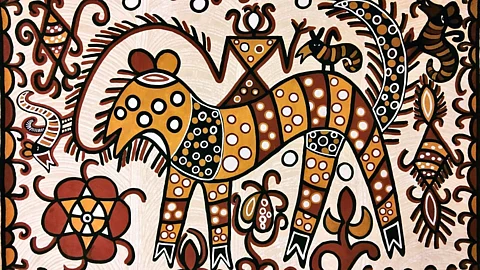
- HOMEGROWN WORLD
- #HGCREATORS
- #HGEXPLORE
- #HGVOICES
- #HGSHOP
- CAREERS
- ABOUT US
- CONTACT US

Do you know why you may know of famous art styles like minimalism, surrealism, etc but probably have yet to hear of a vibrant indigenous art form like Sohrai even though it originates from our country? It can all be tracked down to popularity and marketing. While European schools of art have historically been well recorded and marketed over time, there reside several brilliant art forms in India which are even older but have yet to enter the mainstream cultural zeitgeist because they have not either been preserved or marketed well enough or in some rare cases, have not even been discovered. As a result, they have remained localized and often outside the purview of Indian art history.
With that in mind, let us explore one such indigenous art form called Sohrai, which came into the limelight only during the 90’s but has been practiced for thousands of years. This vibrant artistic tradition was born in the verdant villages of Jharkhand’s Hazaribagh area. More than mere decoration, Sohrai paintings are a window into the soul of Jharkhand’s tribal communities; alluding to themes that elebrate nature's bounty, ancestral reverence, and a deep connection to their homeland.
Sohrai's roots run deep and possibly even date back to prehistoric times. The discovery of the ISCO rock art site in Hazaribagh in 1991 by Shri Bulu Imam further strengthens this theory. According to ASI, the ancient murals in the rock art site were made between 3000 and 7000 BC, during the Paleolithic Age. The motifs adorning these ancient walls bore an uncanny resemblance to the Sohrai paintings of Hazaribagh’s local people, suggesting a possible artistic inheritance passed down through hundreds of generations.
Scholars point to a possible link of the word ‘Sohrai’ originating from the ancient Mundari word 'soroi', meaning 'to lash with a stick', hinting at the age-old connection of villagers using a stick to keep their domestic animals in check. The tribal community of Jharkhand has always depended majorly on their livestock for their economic sustenance.
Traditionally, Sohrai adorns the mud walls of homes during the Sohrai festival, celebrated just after Diwali. This is a time to express gratitude for the harvest and the life-giving power of nature. Women, the custodians of this art form, meticulously prepare the canvas; the mud walls, with a paste of soil and dung which is followed by a white clay wash. Natural pigments then come alive — red ochre symbolizing ancestry, black representing the fertile earth, and white depicting life-giving rice.
The motifs themselves are a captivating language. Geometric patterns represent order and the cosmos, while a menagerie of animals — elephants signifying strength, horses for vitality, and the ever-present peacock embodying abundance — populate the walls. The inclusion of Lord Shiva, the protector of creatures, underscores the reverence for the natural world. Every line and shape whispers a prayer for a bountiful harvest and a harmonious co-existence with nature.
Sohrai, however, is not a relic of the past. It's a dynamic art form that's adapting to contemporary realities. While traditionally confined to mud walls, Sohrai paintings are now finding expression on cloth and paper. These artworks grace art galleries and homes beyond the villages; ensuring the art form's survival while allowing artists to explore new avenues. This adaptation is a testament to the enduring spirit of both the art form and the artistic community as a whole.
The recent recognition of Sohrai art with a Geographical Indication (GI) tag offers a glimmer of hope for its future. However, challenges remain. Development projects replacing mud houses and displacement due to coal mining threaten the very canvas of this art form. Furthermore, with a decline in demand and a shift away from tradition, the practice of passing down this art from mothers to daughters is at risk.
The key to Sohrai's survival lies in generating demand. Individuals, corporations, institutions, and the government all have a role to play. By appreciating and promoting Sohrai art, we can give these vibrant paintings new homes and ensure that his beautiful and vital cultural and artistic tradition continues to whisper its stories for generations to come.
An even more proactive way of keeping alive the legendary artistic tradition would be to learn it for yourself. Folks in Mumbai, now you have the chance to create your very own Sohrai masterpiece at a unique painting workshop being conducted under the guidance of the celebrated artisan Manikchand Mahto from Jharkhand.
Sohrai Painting Workshop
Date: 12 May, 2024
Time: 11:00 am to 12:30 pm
Venue: The Museum Plaza at Dr Bhau Daji Lad Museum, Mumbai
Find out more about the Dr. Bhau Daji Lad Museum here.
If you enjoyed reading this, here's more from Homegrown:
Inside An Audio Project Reclaiming The Cultural Identity Of Indian Tribal Communities
Inside A Pune Studio Working With Tribal & Folk Artists To Preserve Cultural Heritage
Are India’s Dying Regional & Tribal Languages Warning Signs Of Cultural Erosion?
